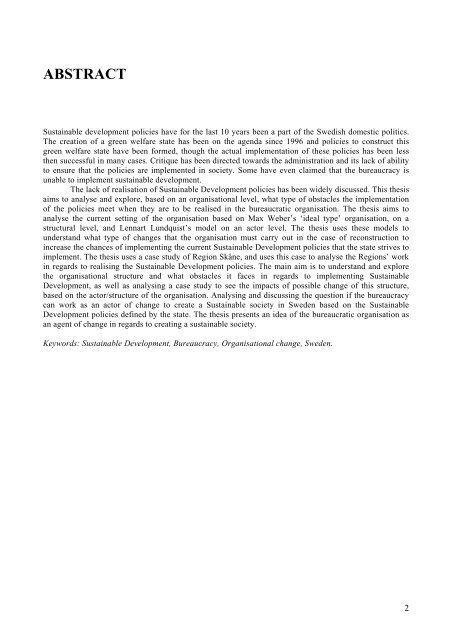From 'grey to green'- investigating the capabilities of the ... - lumes
From 'grey to green'- investigating the capabilities of the ... - lumes
From 'grey to green'- investigating the capabilities of the ... - lumes
Create successful ePaper yourself
Turn your PDF publications into a flip-book with our unique Google optimized e-Paper software.
ABSTRACTSustainable development policies have for <strong>the</strong> last 10 years been a part <strong>of</strong> <strong>the</strong> Swedish domestic politics.The creation <strong>of</strong> a green welfare state has been on <strong>the</strong> agenda since 1996 and policies <strong>to</strong> construct thisgreen welfare state have been formed, though <strong>the</strong> actual implementation <strong>of</strong> <strong>the</strong>se policies has been less<strong>the</strong>n successful in many cases. Critique has been directed <strong>to</strong>wards <strong>the</strong> administration and its lack <strong>of</strong> ability<strong>to</strong> ensure that <strong>the</strong> policies are implemented in society. Some have even claimed that <strong>the</strong> bureaucracy isunable <strong>to</strong> implement sustainable development.The lack <strong>of</strong> realisation <strong>of</strong> Sustainable Development policies has been widely discussed. This <strong>the</strong>sisaims <strong>to</strong> analyse and explore, based on an organisational level, what type <strong>of</strong> obstacles <strong>the</strong> implementation<strong>of</strong> <strong>the</strong> policies meet when <strong>the</strong>y are <strong>to</strong> be realised in <strong>the</strong> bureaucratic organisation. The <strong>the</strong>sis aims <strong>to</strong>analyse <strong>the</strong> current setting <strong>of</strong> <strong>the</strong> organisation based on Max Weber’s ‘ideal type’ organisation, on astructural level, and Lennart Lundquist’s model on an ac<strong>to</strong>r level. The <strong>the</strong>sis uses <strong>the</strong>se models <strong>to</strong>understand what type <strong>of</strong> changes that <strong>the</strong> organisation must carry out in <strong>the</strong> case <strong>of</strong> reconstruction <strong>to</strong>increase <strong>the</strong> chances <strong>of</strong> implementing <strong>the</strong> current Sustainable Development policies that <strong>the</strong> state strives <strong>to</strong>implement. The <strong>the</strong>sis uses a case study <strong>of</strong> Region Skåne, and uses this case <strong>to</strong> analyse <strong>the</strong> Regions’ workin regards <strong>to</strong> realising <strong>the</strong> Sustainable Development policies. The main aim is <strong>to</strong> understand and explore<strong>the</strong> organisational structure and what obstacles it faces in regards <strong>to</strong> implementing SustainableDevelopment, as well as analysing a case study <strong>to</strong> see <strong>the</strong> impacts <strong>of</strong> possible change <strong>of</strong> this structure,based on <strong>the</strong> ac<strong>to</strong>r/structure <strong>of</strong> <strong>the</strong> organisation. Analysing and discussing <strong>the</strong> question if <strong>the</strong> bureaucracycan work as an ac<strong>to</strong>r <strong>of</strong> change <strong>to</strong> create a Sustainable society in Sweden based on <strong>the</strong> SustainableDevelopment policies defined by <strong>the</strong> state. The <strong>the</strong>sis presents an idea <strong>of</strong> <strong>the</strong> bureaucratic organisation asan agent <strong>of</strong> change in regards <strong>to</strong> creating a sustainable society.Keywords: Sustainable Development, Bureaucracy, Organisational change, Sweden.2
















